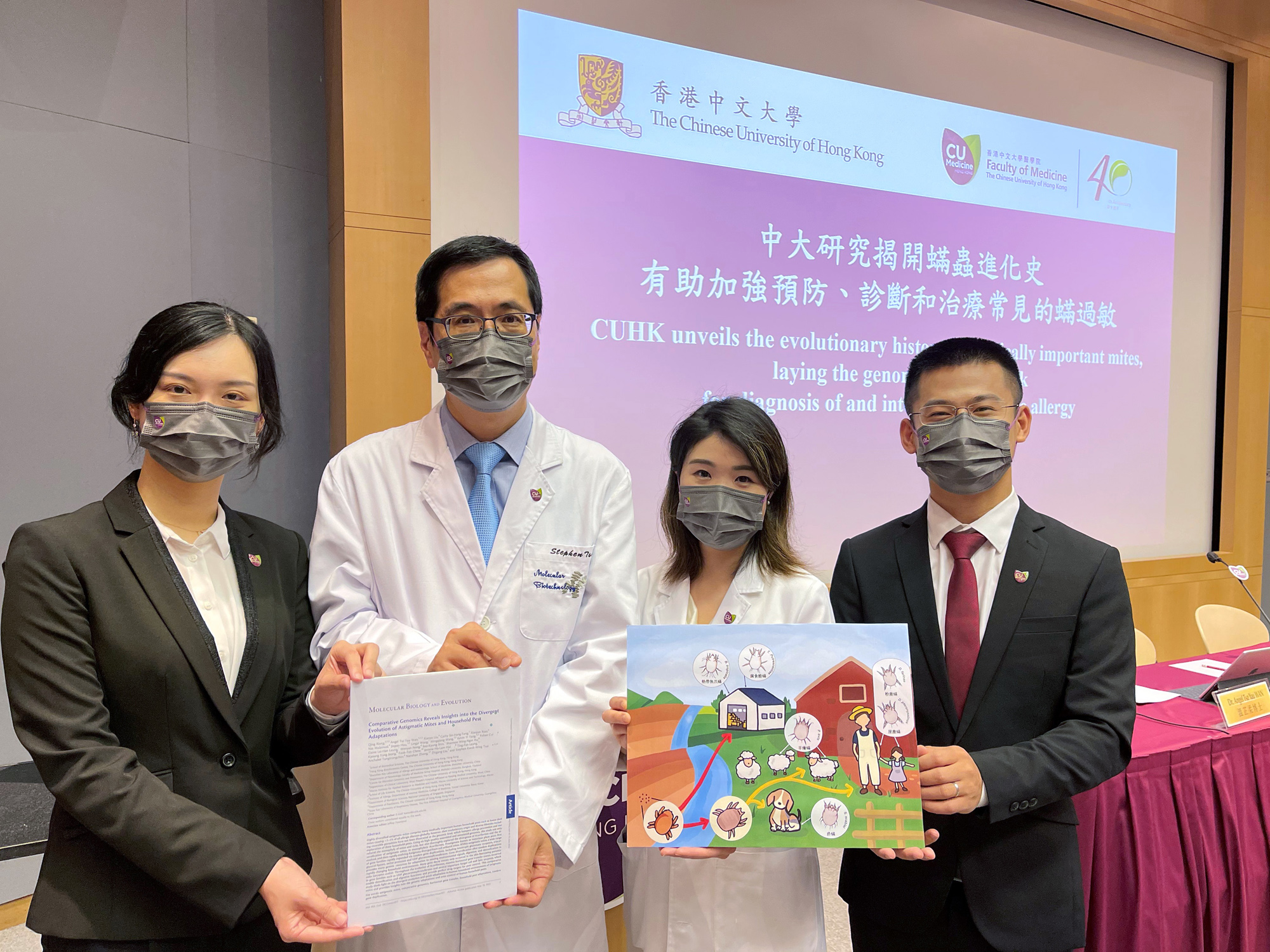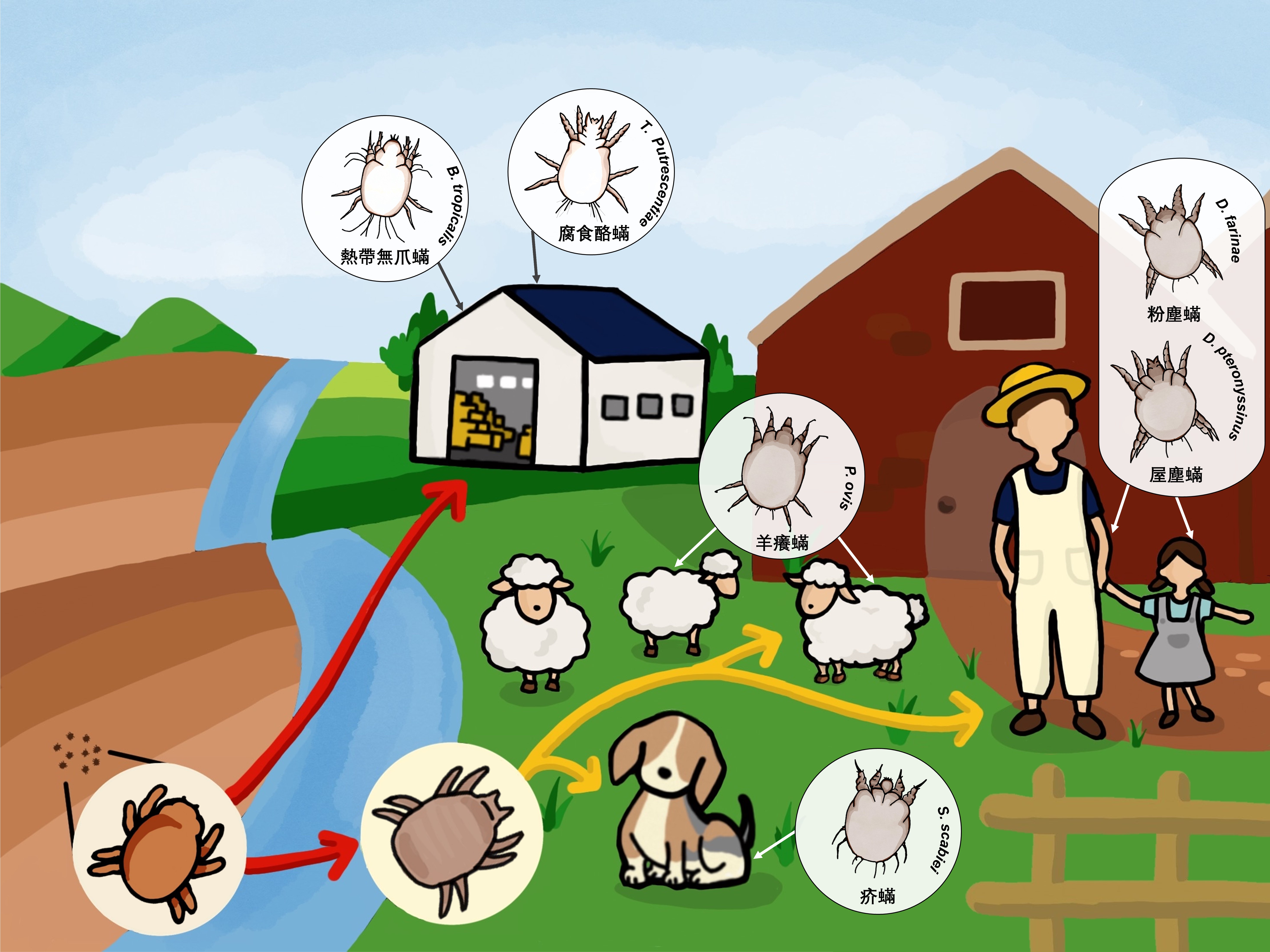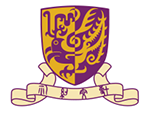徐國榮教授領導之研究揭開蟎蟲進化史 有助加強預防、診斷和治療蟎過敏
A groundbreaking study led by Prof. Stephen K.W. Tsui, Professor and Associate Director (Research) of the School of Biomedical Sciences (SBS), CUHK with researchers from universities in Guangzhou, Shenzhen, Wuxi, Macao, Thailand, South Korea and Singapore, has revealed the divergent evolution of the medically important mites. The findings have been published in Molecular Biology and Evolution, a world-renowned international scientific journal, which can be viewed HERE.
Comprising of Prof. Stephen Tsui as leader, Dr. Angel T.Y. Wan, former Postdoctoral Fellow of SBS, and Dr. Qing Xiong, Postdoctoral Fellow of SBS, the research team reveals the comparative genomics of astigmatic mites using six high-quality genomes and cracking their evolutionary history, from emergence to extreme diversification.
The study involves a wide range of genomic variations and DNA sharing between bacterial and animal genomes via Horizontal Gene Transfer, which is important for the adaptation of mites in different environments. “In our genomic analysis of astigmatic mites, we identified many unusual HGT genes, mainly from soil bacteria. These HGTs introduced functionally important genes and enriched their adaptation novelties, especially in detoxification and digestion. Because these HGT genes have no homologue in humans, they are suggested as perfect drug targets for the pest control of astigmatic mites,” said Prof. Stephen Tsui.
The collaborative research group hopes that this pioneering comparative genomics study not only expands our knowledge of astigmatic mites and provides comprehensive genomic resources for scientific researchers in this field, but also ultimately contributes to the clinical diagnosis of and intervention in mite allergies.
The related coverage by the Communications and Public Relations Office, CUHK can be viewed HERE, whereas the one by CU Medicine is viewable HERE.

(From left) Dr. Angel Wan; Prof. Stephen Tsui; Dr. Agnes S.Y. Leung, Assistant Professor of Department of Paediatrics, CUHK; and Dr. Qing Xiong at the press conference

The study has clearly depicted the whole evolutionary picture of astigmatic mites, especially involving a wide range of genomic variations and DNA sharing between bacterial and animal genomes via Horizontal Gene Transfer for the adaptation of mites in different environments
香港中文大學(中大)生物醫學學院教授及副院長(研究)徐國榮教授領導一項突破性研究,與來自廣州、深圳、無錫、澳門、泰國、南韓及新加坡等地的院校合作,成功揭開「無氣門蟎」的進化過程。研究結果已於著名國際進化生物學期刊Molecular Biology and Evolution發表,論文全文可按此處參閱。
研究團隊由徐國榮教授帶領,包括生物醫學學院前博士後研究員溫芷柔博士,以及學院博士後研究員熊慶博士等。團隊利用六個優質基因組對無氣門蟎進行比較基因組學分析,並揭開蟎蟲由「出現」至演化成「極端多元化」這過程的進化史。
研究透過「水平基因轉移」引入了具重要功能的基因,加強了蟎蟲在不同環境的適應力。徐國榮教授表示:「在無氣門蟎的基因組分析中,我們發現了許多來自土壤細菌的異常基因水平轉移。這些轉移引入了具重要功能的基因,加強了蟎蟲的適應力,尤其在解毒和消化方面。由於人類並沒有這些基因轉移,因此它們可被視為防治無氣門蟎的理想藥物靶點,針對這些獨特基因可以找出合適的化合物作為有效控制蟎蟲的工具。」團隊期望這項突破性的比較基因組學研究,能增加相關領域科研人員對無氣門蟎的認識,為他們提供全面的基因組學資源,最終有助於蟎過敏的臨床診斷和干預。
中大傳訊及公共關係處的有關報導請按此處瀏覽;而中大醫學院的報導可按此瀏覽。

(左起)溫芷柔博士、徐國榮教授、中大兒科學系助理教授梁詩彥醫生,及熊慶博士於新聞發布會

研究成功揭開無氣門蟎的進化過程,證實當中涉及廣泛基因組變異,並透過水平基因轉移引入了具重要功能的基因,加強了蟎蟲在不同環境的適應力
香港中文大学(中大)生物医学学院教授及副院长(研究)徐国荣教授领导一项突破性研究,与来自广州、深圳、无锡、澳门、泰国、南韩及新加坡等地的院校合作,成功揭开「无气门螨」的进化过程。研究结果已于著名国际进化生物学期刊Molecular Biology and Evolution发表,论文全文可按此处参阅。
研究团队由徐国荣教授带领,包括生物医学学院前博士后研究员温芷柔博士,以及学院博士后研究员熊庆博士等。团队利用六个优质基因组对无气门螨进行比较基因组学分析,并揭开螨虫由「出现」至演化成「极端多元化」这过程的进化史。
研究透过「水平基因转移」引入了具重要功能的基因,加强了螨虫在不同环境的适应力。徐国荣教授表示:「在无气门螨的基因组分析中,我们发现了许多来自土壤细菌的异常基因水平转移。这些转移引入了具重要功能的基因,加强了螨虫的适应力,尤其在解毒和消化方面。由于人类并没有这些基因转移,因此它们可被视为防治无气门螨的理想药物靶点,针对这些独特基因可以找出合适的化合物作为有效控制螨虫的工具。」团队期望这项突破性的比较基因组学研究,能增加相关领域科研人员对无气门螨的认识,为他们提供全面的基因组学资源,最终有助于螨过敏的临床诊断和干预。
中大传讯及公共关系处的有关报导请按此处浏览;而中大医学院的报导可按此浏览。

(左起)温芷柔博士、徐国荣教授、中大儿科学系助理教授梁诗彦医生,及熊庆博士于新闻发布会

研究成功揭开无气门螨的进化过程,证实当中涉及广泛基因组变异,并透过水平基因转移引入了具重要功能的基因,加强了螨虫在不同环境的适应力



